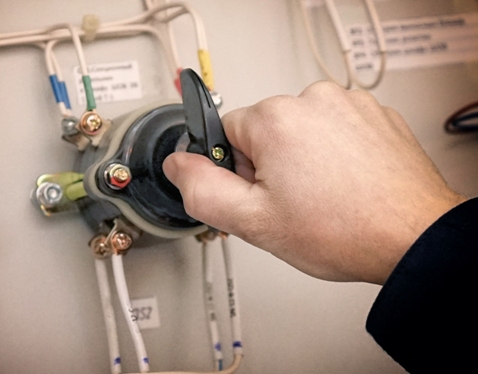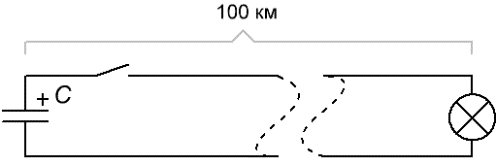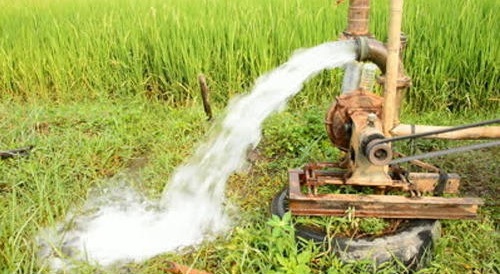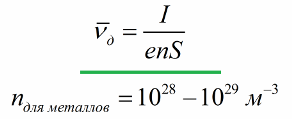Speed of electric current
Let's do this thought experiment. Imagine that there is a village at a distance of 100 kilometers from the city and that a wire signal line about 100 kilometers long with a bulb at the end is laid from the city to that village. A shielded two-core line, it is laid on supports along the road. And if we now send a signal over this line from town to village, how long will it take for it to be received there?

Calculations and experience tell us that a signal in the form of a light bulb will appear at the other end in at least 100/300000 seconds, that is, in at least 333.3 μs (without taking into account the inductance of the wire) in the village will a light will come on, which means that a current will be established in the wire (for example, we use a direct current of charged capacitor).
100 is the length of each vein in our wire in kilometers, and 300,000 kilometers per second is the speed of light—the speed of propagation electromagnetic wave in a vacuum. Yes, the "motion of electrons" will propagate along the wire at the speed of light.

But the fact that the electrons start moving one after the other at the speed of light does not mean at all that the electrons themselves are moving in the wire at such a tremendous speed. Electrons or ions in a metal conductor, in an electrolyte, or in another conductive medium cannot move that fast, that is, the charge carriers do not move relative to each other at the speed of light.
The speed of light in this case is the speed at which the charge carriers in the wire begin to move one after the other, that is, it is the speed of propagation of the translational motion of the charge carriers. The charge carriers themselves have a "drift velocity" at direct current, say in a copper wire, of only a few millimeters per second!
Let's make this point clear. Let's say we have a charged capacitor and to it we attach long wires from our light bulb installed in a village at a distance of 100 kilometers from the capacitor. Connecting the wires, that is, closing the circuit, is done with a switch manually.
What will happen? When the switch is closed, charged particles begin to move in those parts of the wires that are connected to the capacitor. Electrons leave the negative plate of the capacitor, the electric field in the dielectric of the capacitor decreases, the positive charge of the opposite (positive) plate decreases — electrons flow into it from the connected wire.
Thus, the potential difference between the plates decreases.And since the electrons in the wires adjacent to the capacitor began to move, other electrons from distant places on the wire come to their places, in other words, the process of redistribution of electrons in the wire begins due to the action of an electric field in a closed circuit. This process spreads further along the wire and finally reaches the signal lamp filament.
So the change in electric field propagates along the wire at the speed of light, activating the electrons in the circuit. But the electrons themselves move much more slowly.

Before we go any further, consider a hydraulic analogy. Let the mineral water flow from the village to the city through a pipe. In the morning, a pump was started in the village and it began to increase the water pressure in the pipe to force the water from the village source to move to the city. The change in pressure spreads along the pipeline very quickly, at a speed of about 1400 km / s (it depends from the density of the water, from its temperature, from the magnitude of the pressure).
A fraction of a second after the pump was turned on in the village, water started moving into the city. But is this the same water that is currently flowing through the village? No! The water molecules in our example push each other and they themselves move much more slowly, since the speed of their deviation depends on the magnitude of the pressure. The crushing of molecules against each other propagates many orders of magnitude faster than the movement of molecules along the tube.
So it is with an electric current: the speed of propagation of an electric field is similar to the propagation of pressure, and the speed of movement of electrons that form a current is similar to the movement of water molecules directly.

Now let's get back directly to the electrons. The rate of orderly motion of electrons (or other charge carriers) is called the drift rate. Its electrons gain through the action external electric field.
If there is no external electric field, then the electrons move chaotically inside the conductor only by thermal motion, but there is no directed current, and therefore the drift speed on average turns out to be zero.
If an external electric field is applied to a conductor, then depending on the material of the conductor, on the mass and charge of the charge carriers, on the temperature, on the potential difference, the charge carriers will begin to move, but the speed of this movement will be significant less than the speed of light, about 0.5 mm per second (for a copper wire with a cross section of 1 mm2, through which a current of 10 A flows, the average speed of electron drift will be 0.6–6 mm / s).
This speed depends on the concentration of free charge carriers in the conductor n, on the cross-sectional area of the conductor S, on the charge of the particle e, on the magnitude of the current I. As you can see, despite the fact that the electric current (the front of the electromagnetic wave) propagates along the wire at the speed of light, the electrons themselves move much more slowly. It turns out that the speed of the current is a very low speed.
